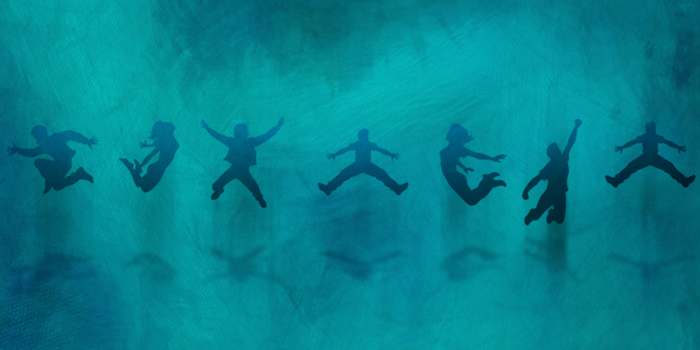
All trampoline parks have one thing in common: a ton of square footage with interconnected woven polypropylene material stretched across floor space up to the ceiling’s crease. Matter of fact, that’s the only thing you can count on when stepping foot into one of these facilities. Variables in each location include, but are not limited to the following: amount of activities, level of difficulty, use of floor space, staff per participant ratio, and airtime. So next month when another park has opened their doors in your neighborhood, know that even though you’ve been to one trampoline park, stepping foot into a new park is like stepping foot onto another planet. Yes, it can be that drastic! This is especially good news if your previous flying-through-space experience was less than ideal.
In this article, I’ll outline the features of two nearby trampoline parks, Sky Zone and Get Air — both of which provide a unique jumping experience, especially for the child who stands somewhere on the autism spectrum. As we pull our sweaty, grippy-bottomed socks off for the day, you’ll then begin the process of choosing a park that will best fit the special needs and interests of your child.
RECENT: 8 Training Types to Progressively Integrate Social Networks
The sample schedules below, individualized for each park’s setup, will help assist in the planning and managing process, ensuring that your next gym-alternative jumping adventure engages and accommodates the child—all while having FUN!
Sky Zone
This experience begins by signing/printing a waiver online. Walk through the doors with your signed waiver in hand (or submit electronically) and register.
If you’re on a tight schedule and wait time is an issue, schedule a jump time online as you submit the waiver. Do note: all sales are final. That’s one option. You could also see how the day unfolds and arrive without a predetermined time frame. Walk-ins are scheduled on the half hour and if the facility reaches their capacity maximum, wait time can be extended. Although wait time is something we often want to minimize, this could also be a worthwhile chunk of time to use the restroom, find a locker, go for a mini walk, get acclimated to the surroundings, or get a snack. I recommend beginning with 30 minutes of airtime and progress as familiarity, engagement, and stamina increase. Obviously, if the duration of jump time needed to be shortened, you can always leave. If 30 minutes is not enough time, you can always extend to 60, 90, or 120 minutes (you’ll just have to pay the difference).
Change socks, secure your shoes and personal belongings in the locker, and attend the mini rules meeting. Here, a staff member will explain the jumping Dos and the Don’ts to you and the other park patrons sharing the airtime. These are a few guidelines he or she will cover in three minutes time:
- Time limit
- Jumping Assignment
- Rest
As you can see, these are three valuable minutes. Interpret them correctly and each part serves as helpful structures to place your training within.
Time Limit
Affixed on one wall in each play station is a digital clock. This shows exactly how much time you have remaining. Pace yourself by keeping an eye on the clock. For example, divide your total time between the three activities. In our case, I wanted more attention in free jump, so less time was allotted for the other areas.
Before jumping, reiterate that when the buzzer goes off, we walk off the courts and locate our personal belongings in order to go home. This sets up a clear start and end point with a protocol in place to move off the courts.
Jumping Assignment
Each area (Free Jump, Dodgeball, and the Foam Pit) at Sky Zone has multiple staff members observing, watching, assisting, and reinforcing the safety rules and expectations. Aside from Dodgeball, you can move freely from one station to the other whenever you’d like.
If you remain in the free jump area, jumpers are split by size, therefore little ones occupy one half of the space and teens and adults occupy the remaining half. One jumper per square, at all times, is advised and maintained.
Dodgeball is setup in time slots, so you can’t randomly walk on the courts at any given moment like you can in free jump (if squares remain). Therefore, if Dodgeball is high on your priority list, make sure you schedule a slot of time within your airtime.
The large foam pit area is split into two sections with a staff member in each section. One jumper is permitted to jump per foam pit. Other jumpers have to wait their turn until the previous jumper climbs up from the foamy pit and clears the area entirely.
Rest
You may rest any time you’d like to by walking off the courts. There are benches, tables, floor space, bathrooms, water fountains and a snack shop to accommodate. They only ask that you don’t block the stairwells that lead to each play station and that you don’t lie down on the trampoline space.
If this is a new endeavor for you, regardless if you train weekly, biweekly, or everyday, jumping for an extended period of time will kick you in the ass. I remember looking at the clock seven minutes in, already profusely sweating and breathing heavily. What’s nice is that you put as much effort into this chunk of time as you want to. For our first time, Blaine and I jumped for five minutes and followed up with two minutes of rest. I allowed him to set the pace and didn’t push him to work past exhaustion — this is a precursor to a meltdown. The freedom to rest and take breaks throughout was very important for us.
I’m not sure if this sounds strict or not, but if this is your first time attending a jump park, you’ll be thankful. The safety reinforcements set guidelines in place, giving you and the child better control of self and spatial awareness. As much as we hope other parents would reinforce the three-minute rules meeting, you can’t count on this. But as I’ve witnessed, you can count on the staff. If any of the above rules are broken, you are redirected politely yet firmly. This makes your job much easier, and again, gives you more room to plan for the fun stuff rather than dodging toddlers in complete chaos.
If this is somewhere you’d like to go for your first or next jumping adventure, consider the following sample schedule. This will at least give you some ideas worth trying.
SAMPLE SCHEDULE
Notes: Steps 1-5 give us perspective of what to expect before we actually place foot on the trampoline. The drive can be very telling. This may be the time to insert gaming, silence, heavy or light conversation, and/or a nap. Allow the child to dictate how this window of time is spent. For example, forcing conversation can have a detrimental effect whereas a ride in silence can allow the child to relax and maintain/accumulate energy stores (more on this topic in future articles). Rest is highlighted and the emphasis is that he or she can control this component throughout the day. More time is placed in Free Jump because there are specific things to accomplish that complement gym training concepts: differentiating between low, medium, and high jumps, practicing presentation and modeling behavior, coordinating our movements in repetition and order. Less time is given to the other locations since free jump is priority. Memory Game is when one player takes the lead and makes a movement. The partner has to repeat. The first player repeats first movement and adds a new movement. The other player repeats sequence. Continue until a player breaks sequence. The remaining 10 minutes of free time allows the child to have free reign. This is where you can gauge interest. The child may want to spend 10 minutes playing Dodgeball. He or she may want to repeat everything you did in Free Jump. Be flexible here! Step 10 reinforces that when we hear the buzzer it’s time go home and we have specific steps to follow to do so.
Get Air
And now we enter Get Air. Similar to Sky Zone, this experience begins by going online and signing a waiver. You may also electronically sign a waiver when you arrive— roughly six computers line the entrance hallway to complete this step before choosing a time slot. Again, minimizing unnecessary wait time, I’d suggest completing this step before walking through the doors. Airtime is chunked into one-hour increments and priced by height and duration. Buy socks, wrap your jump band around your wrist, and place your shoes and personal belongings in the locker area. What’s next? Get air! No briefing or rules meeting? Correct. It’s a free-fall. You may begin anywhere you’d like, with the exception of the Ninja Course, as this is a timed event and completed in pairs. You have to wait your turn for the next available opening.
Get Air is enormous, much bigger than Sky Zone, and each activity ranges widely in level of difficulty.
Activities include:
- Free Jump
- Dodgeball
- Foam Pits (with and without netted swings and ladders)
- Slackline
- Slam Ball
- Ninja Course
- Fidget Ladder
- Kiddie Court
Click on each activity and you’ll have the opportunity to view the specs and gauge difficulty. In regards to time limits, jumping assignment, and rest, you’re in total control of this. Clocks do not line the walls and there is no oral or visual indicator when your time is up. There is no jumping assignment and staff members are not situated in each area. The floor plan has no clear directional route and jumping space is not split into weight classes — this is where a schedule will come in handy. The cap on jumpers is much higher; therefore, the ratio of jumper to staff is grossly disproportionate. Likewise, the total amount of attendants jumping simultaneously is at an ultimate high in comparison to Sky Zone. Rest can be taken as needed, as there is a couch area, water fountain, snack shop, and bathrooms to accommodate.
If this is somewhere you’d like to go for your first or next jumping adventure, consider the following sample schedule. You’ll see how I called upon previous jumping experiences at Sky Zone to maximize our time spent at Get Air. This will at least give you some ideas worth trying.
SAMPLE SCHEDULE
Notes: This schedule automatically gives you direction in this large space, keeping your session in focus and on pace. Steps 1-4 give us perspective of what to expect before we actually place foot on the trampoline. The drive can be very telling. This may be the time to insert gaming, silence, heavy or light conversation, and/or a nap. Allow the child to dictate how this window of time is spent. Rest is highlighted and the emphasis is that he or she can control this component throughout the day. Run the Walls is where each player remains in his or her lane. The grade of the trampoline floor gradually rises to reach the ceiling. Run to the top and run or slide back to the starting place. This is one rep. 1-2-3 is a game where one player counts 1-2-3 while jumping. After saying three, he or she performs an action. The other player repeats the action simultaneously. I like this game because it gives us a rhythm to work with followed by improvisation of movement. It’s spontaneous and quick. There are multiple types of foam pits, so this grouping progresses to using the swing. The slackline is TOUGH. I have not seen an adult or child cross it without falling before reaching the other end. Again, assuming this is your first time, provide support and lessen over time. The remaining 10 minutes of free time allows the child to have free reign. This is where you can gauge interest. The child may want to spend 10 minutes running the walls. He or she may want to repeat a previous game played. Be flexible here!
RELATED: Take Your Training Day to the Zoo
Clearly, one park is not better than the other; one park is better for your child’s individual needs. In our case, Sky Zone was a great option for our trampoline park introduction (if you will) and we returned multiple times before venturing to somewhere new. I can, without hesitation, say that if Get Air was our first option, it may have ended poorly as I do believe it would’ve been too much to take in all at once (longer time frame, less structure, no rules meeting, larger amount of people, more noise, greater physical challenge, etc.). Get Air was the perfect option to use once basic trampoline park etiquette was established and is still very much a challenge in progress. Now we have specific exercises at the gym to strengthen our abilities for this off-site spot, which in turn gives Blaine immediate reinforcement and concrete reason to do something in training he’d otherwise want no part of. This loop effect gives meaning to our training, allows us to work on our weaknesses (again, something he’d otherwise not face), and test our strength upon our return.
Hopefully these less-advertised details above give you an eye-opening sense of what to expect and plan for the next time you’re looking to explore a gym-training, flying-through-space alternative.
Find A Park Near You
Sky Zone
Get Air









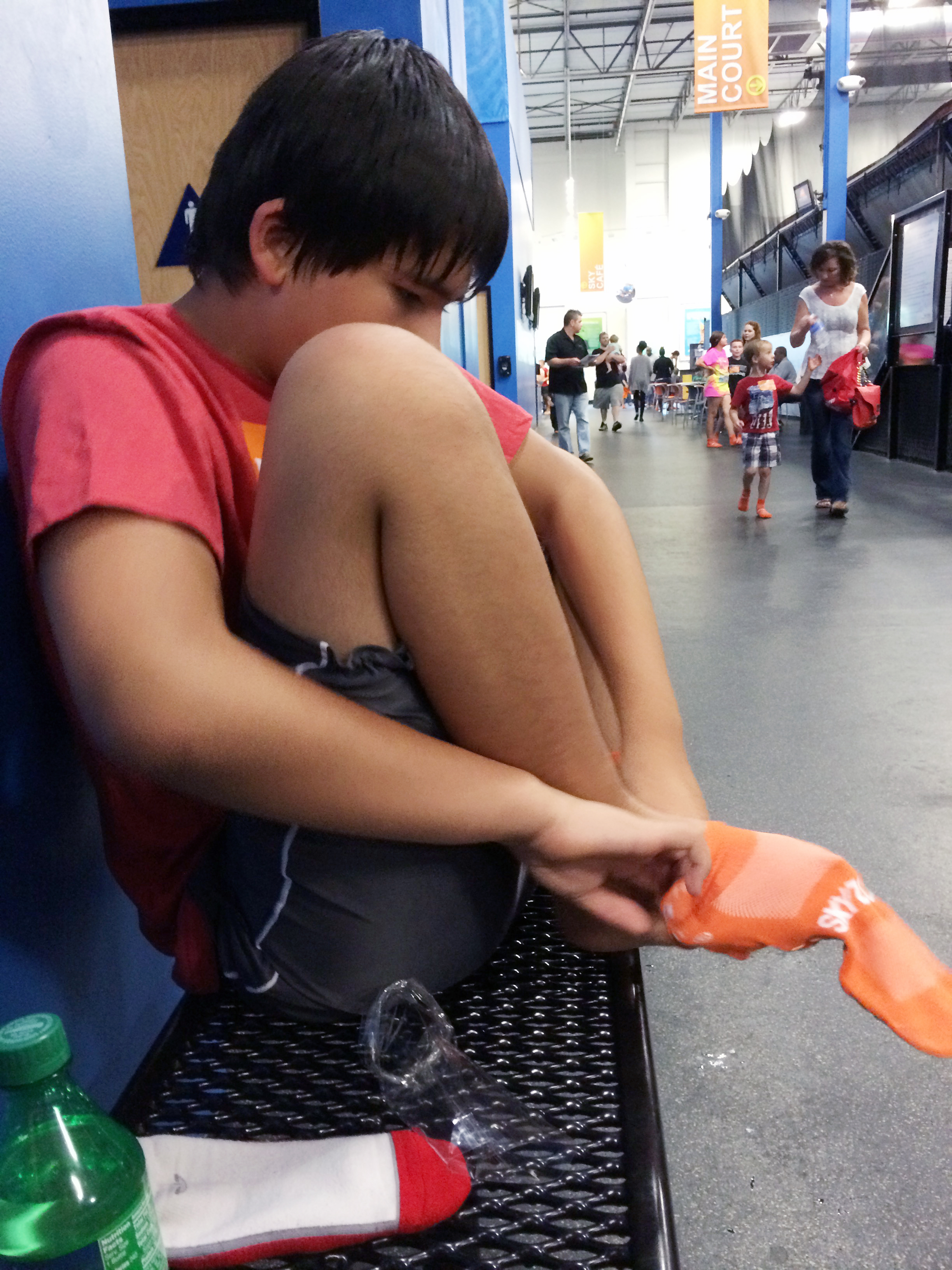

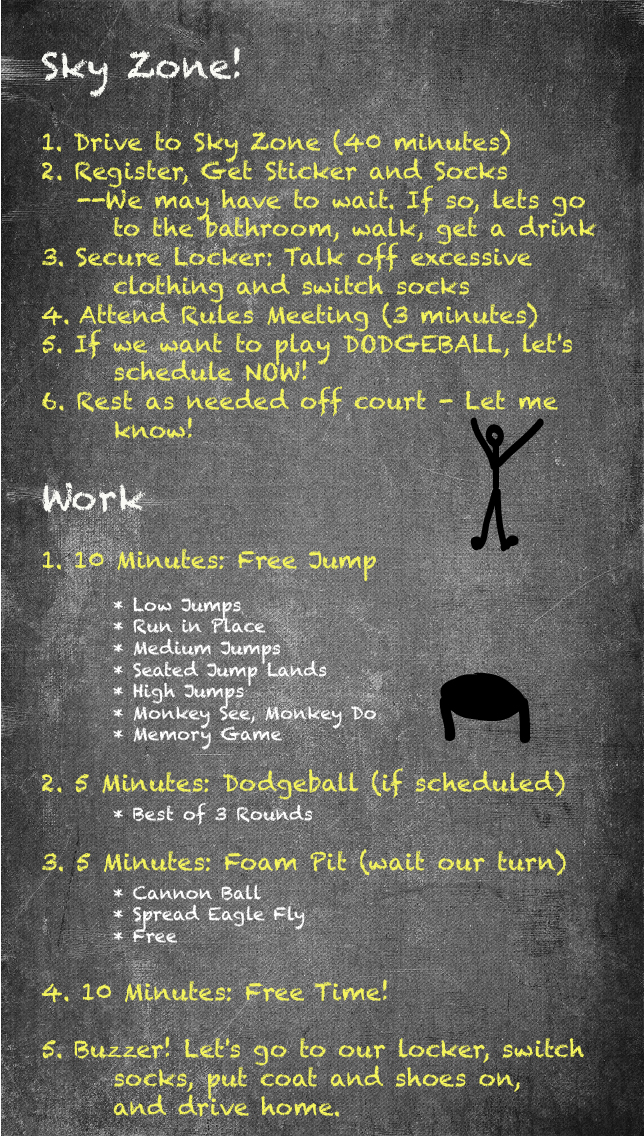
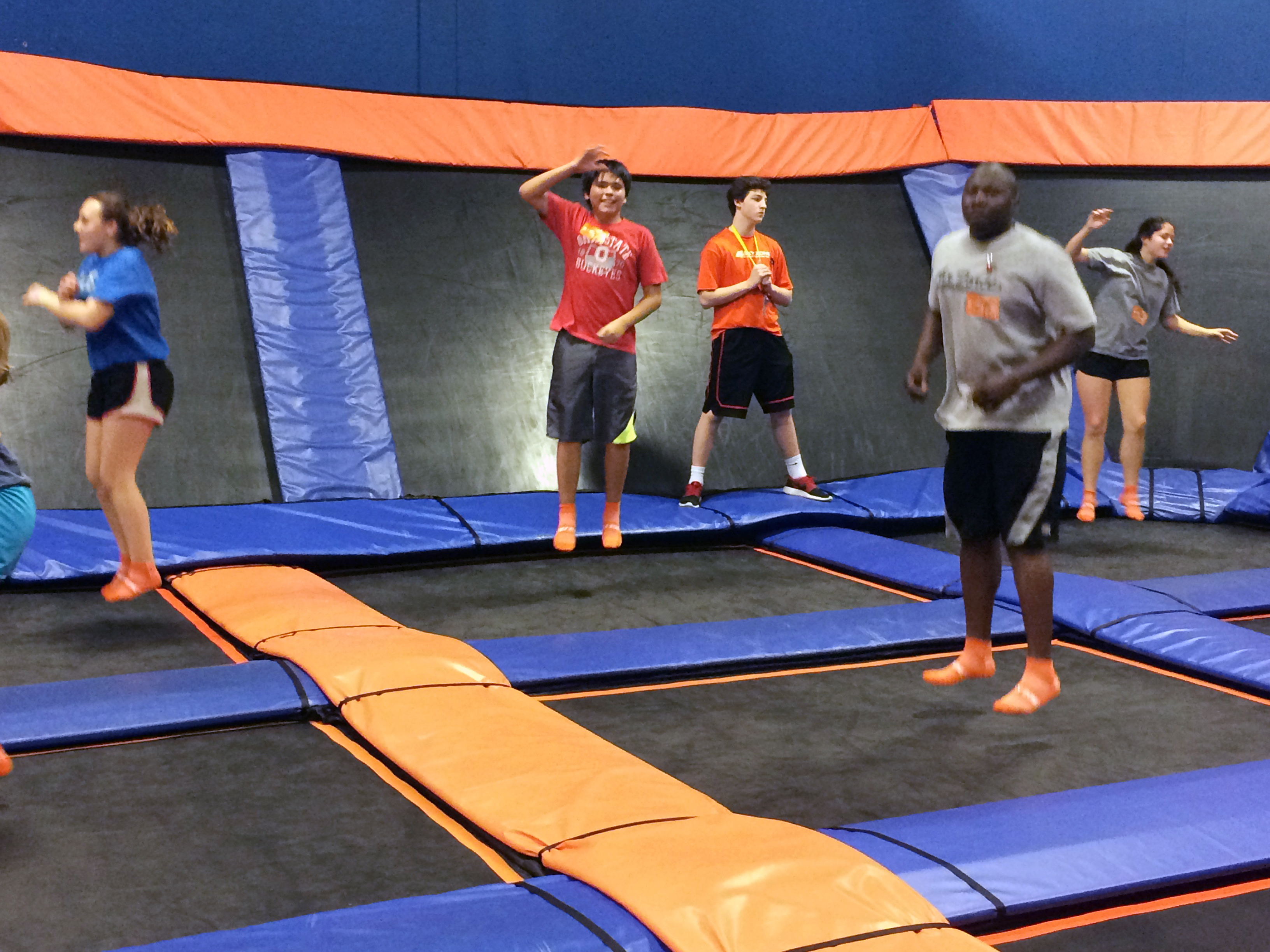
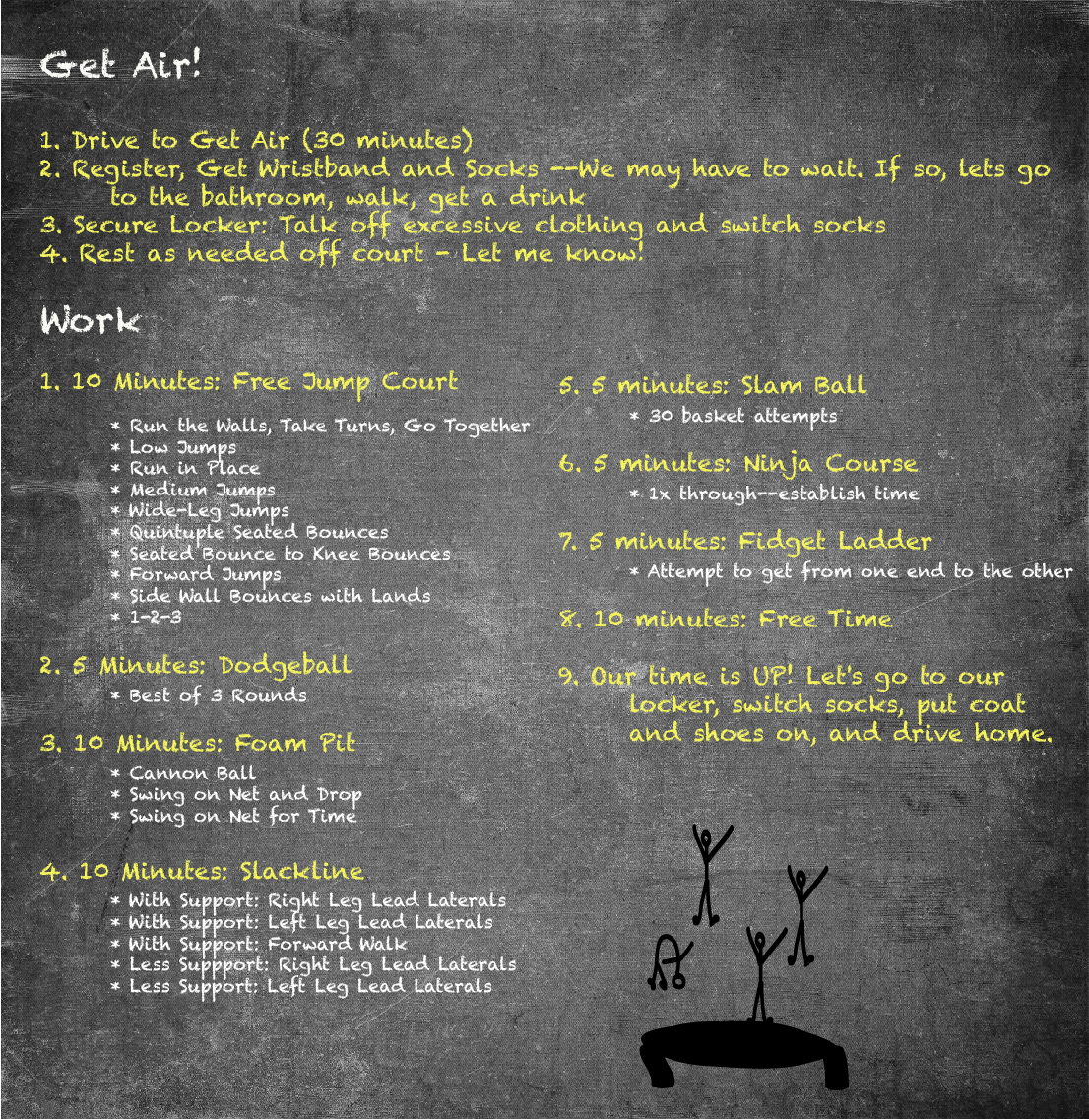

3 Comments